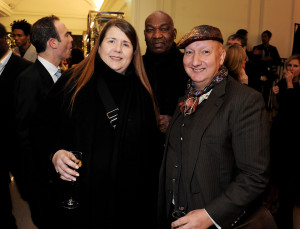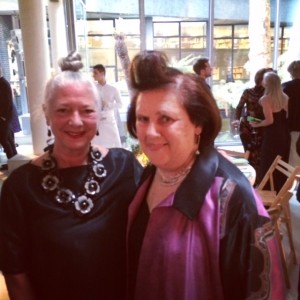Students across the world now find themselves dumped with crippling sums to pay off and under pressure to find a job – any job – or to take out a further loans to try to build a business.

Looks from the RCA MA Fashion Gala 2014 graduate collections by: (left)- Faye Oakenfull, (right)-Ida Gro Christiansen. Photo:Dominic Tschudin
Before the shocking news that Professor Louise Wilson, the lightning bolt of Central Saint Martins and its fashion students, had passed away; and before Wendy Dagworthy, the head of fashion at the Royal College of Art, had decided to retire after 16 years, leaving two of the UK’s most important fashion schools rudderless – the writing was already on the studio walls.
Fashion universities in the UK are facing a crisis.
Exactly thirty years since John Galliano graduated from St Martins, the class of 2014 has left college with inventive, imaginative and intriguing work. But also with something much less palatable: a mountain of debt.
Since the law governing tuition fees and student loans changed in 2010, putting English education on a par with the established American system, it is harder than ever to imagine a Lee McQueen, a brilliant, wilful, taxi driver’s son, making it through college today.
Students across the world now find themselves dumped with crippling sums to pay off and under pressure to find a job – any job – or to take out a further loans to try to build a business.
That situation highlights the importance of the LVMH initiative that last week offered 300,000 euros to fashion prize winner Thomas Tate – and a sum of 100,000 euros each to three runners up. Other awards systems, particularly the CFDA Vogue fashion fund in the US, show how committed the fashion industry and its luxury conglomerates are to finding the talent for tomorrow. In Italy, too, Giorgio Armani, the maestro of Milan, is supporting young talent each season.

Designer Thomas Tait – winner of the LVMH prize of 100,000 euros
Yet for all the fortunate fashion winners, there are so many others struggling.
‘Everyone seems to be masking it over – but it is a problem, we were just so lucky,’ says Dagworthy, referring to the minimal cost she faced as a fashion student at the start of her own career.
Dagworthy is the RCA’s Head of Programmes and Dean of School for womenswear and she said that she was proud at the depth of work for the final year show: the interesting fabrics, exceptional knits and exceptional menswear, under the guidance of tutors, Tristan Webber, Ike Rust, and Sarah Dallas.
But the head of an art school that produced legendary designers like Ossie Clark and Zandra Rhodes admitted that the only way her most talented students can get through college now is on bursaries. Others have to take on menial jobs to raise money.
The many successful RCA alumni at last week’s event included milliner Philip Treacy, eco-designerChristopher Raeburn, Nina Ricci’s Peter Copping, and Erdem Moralioğlu who is succeeding in building his own business.

Milliner Philip Treacy and RCA Senior Menswear tutor Ike Rust
‘But it’s a challenge to study fashion now,’ said Erdem, who was brilliant enough to win scholarships to take him through the RCA years.
The last time I talked in depth to Louise Wilson was shortly after the international collections, at a lunch with my photographer friend Chris Moore.
We sat in The Grain Store in the new complex at London’s King’s Cross. The mighty new campus is far from the warren of rooms in the old building in the city center – the site that Louise was so loath to leave and where future fashion stars like hat-maker Stephen Jones had roamed free.

Louise Wilson and Stephen Jones
With her familiar expletives peppering the conversation, Louise railed against the influx of foreign students, helpful for paying the college bills, but too timid, too founded in their own culture and language, for their professor to be able to cut them down brutally- and then watch them flower.
But all colleges now have a high percentage of foreign students. According to Dagworthy, teaching establishments in Great Britain and elsewhere aim roughly for one third home grown students; one third from across Europe; and one third pan Asian. All the latter, and many of the other foreign students, need wealthy parents to afford a minimum of £30,000 fees a year. The overall financial requirement is of foreign students likely to be £100,000 pounds, including the cost of living, by the end of course.

Suzy and Professor Wendy Dagworthy
I have been a few times to the Academy of Art University in San Francisco and to the shows it holds each season during New York fashion week. There, the students of Asian origin are in the majority, and they shine at the shows. But all students either are funded or take on part time paying jobs.
‘When I went to Saint Martins it was eight pounds a term!” said Gladys Perint Palmer, the Executive Director of Fashion at the San Francisco University, and also a well-known fashion illustrator. She was referring to charges in the London school in the late 1960′s.
For Elisa Stephens, President of the Academy, established by her grandfather in 1929, there is an even bigger future ahead than the current 18,000 undergraduate and graduate students, who make up the largest private art and design school in the United States.
The goal is to expand over five years to 100,000 students, with the vastly increased numbers coming from on-line students working on the university’s digital courses that are already highly developed.
‘My aim, when we built this platform, was to a capacity of 100,000,’’ says Doctor Stephens, who believes the development from bricks and mortar in a San Francisco location to a digital platform is do-able. In her vision, a mom in rural Wisconsin or a smart guy from Taiwan can do the online course and then participate in the actual Californian college for a semester.
But is this really an answer to fashion education: an alternative on-line faculty that is technically smart and hyper modern? The students might learn a lot, but they would not benefit from one-to-one consultation with teaching staff, nor from the camaraderie of a campus. On the positive side, potential students cut off from higher education by its cost, can digitally develop their talents.
So here is the BIG question. Can the computer cut the cost of fashion schooling and create a virtual studio in a 21st century world – in an industry where touch and feel are as crucial as the look?
I would love to hear your thoughts from across the world.

